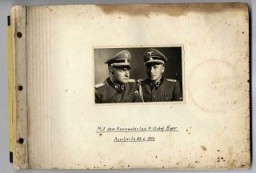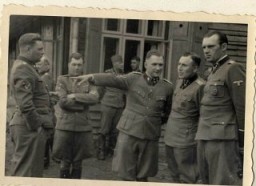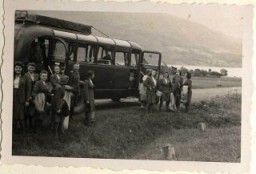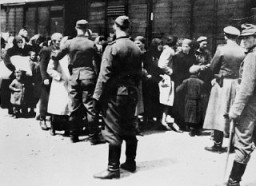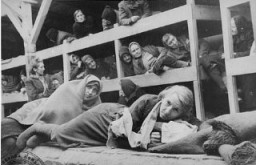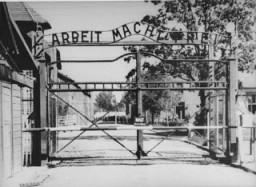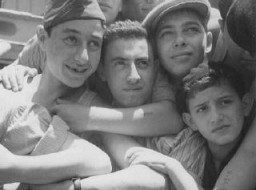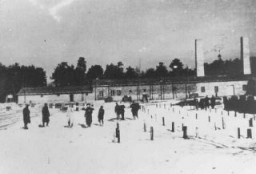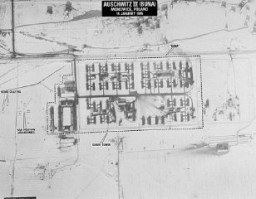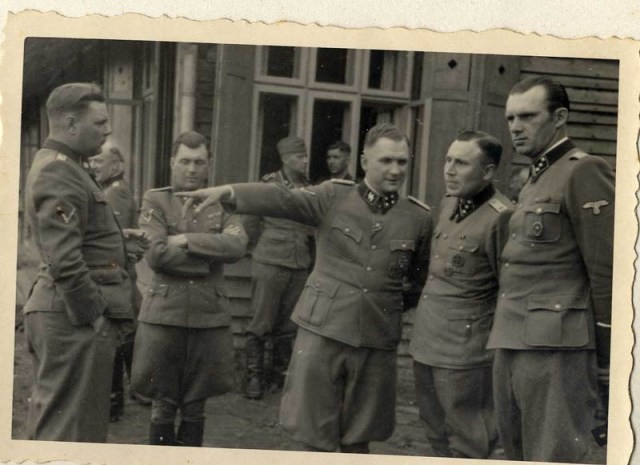
Auschwitz Through the Lens of the SS: The Album
Shortly after World War II, an American intelligence officer living in Germany uncovered a personal album of photographs chronicling SS officers’ activities at Auschwitz-Birkenau. The Museum received this photograph album in 2007. The rare images show Nazis singing, hunting, and even trimming a Christmas tree. They provide a chilling contrast to the photographs of thousands of Hungarian Jews deported to Auschwitz at the same time.
Karl Höcker's photograph album includes both documentation of official visits and ceremonies at Auschwitz as well as more personal photographs depicting the many social activities that he and other members of the Auschwitz camp staff enjoyed.
Many of the most remarkable photographs are taken at Solahütte, a little known SS resort some 30 km south of Auschwitz on the Sola River. Archival records reveal that the SS rewarded Auschwitz guards who performed their work at Auschwitz in an exemplary fashion with a trip to Solahütte. Danuta Czech, in her daily chronicle of the camp wrote that on August 18, 1944, "SS Private Johann Antoni and SS man Hans Kartusch from the 3rd Guard Company of Auschwitz II receive eight days' special leave in the SS recreation center of Solahütte as recognition for the successful use of their weapons during the escape of four prisoners, in spite of darkness."
Though there are photos taken upon visits to Solahütte throughout the album, a series of photographs document a social gathering at Solahütte for the SS hierarchy. In attendance were some of the most notorious officers of the concentration camp system.
Rudolf Höss, the former commandant, returned to Auschwitz between May and July 1944 specifically to oversee the arrival of the Hungarian Jews. Josef Kramer was the commandant of Auschwitz-Birkenau. Later, as commandant of Bergen-Belsen, he would be known as the "Beast of Belsen." And Dr. Josef Mengele selected "specimens" for his medical experiments from among the transports of Hungarian Jews. Höcker and Auschwitz I commandant Richard Baer are there, shown in conversation with Höss, Kramer, and Mengele, along with other officers who have yet to be identified.
Perhaps the most extraordinary photograph depicts an accordionist leading a sing-along for approximately 70 SS men. In the front row of the group are Höcker, SS-Hauptscharführer Otto Moll (the supervisor of the gas chambers), Höss, Baer, Kramer, Franz Hössler (commander of the female prisoner compound at Birkenau), and Mengele. These are some of the only known photographs of some of these men, including Mengele, taken while they were stationed at Auschwitz.
Several pages are devoted to a day trip for SS Helferinnen (female auxiliaries, young women who worked for the SS as communications specialists) on July 22, 1944. They arrive at Solahütte and run down a ramp accompanied to the music of an accordionist. A full-page spread of six photographs entitled "Hier gibt es Blaubeeren" (Here there are blueberries) shows Höcker passing out bowls of fresh blueberries to the young women sitting on a fence. When the girls finish theatrically eating their blueberries for the camera, one girl poses with fake tears and an inverted bowl. Only miles away on the very same day, 150 prisoners (Jews and non-Jews) arrived on a transport to Auschwitz. The SS selected 21 men and 12 women for work, and killed the remaining members of the transport in the gas chambers.
Several pages depict a ceremony on September 1, 1944, commemorating the opening of the SS military hospital at the entrance to Birkenau. The festivities included an honor guard and official presentations by Baer and Dr. Enno Lolling. Scores of Nazi officials including many of the physicians (most notably Dr. Eduard Wirths and Dr. Carl Clauberg) and nurses attended the ceremony. The Allies bombed the field hospital on December 26, 1944, killing five SS personnel.
The album also contains photographs taken most likely in the aftermath of that very same December 26, 1944, air raid. These photographs were taken just weeks prior to the SS evacuation of the camp to avoid capture by Soviet troops. That day, the US 455th Bombing Group hit targets on the outskirts of Birkenau, where the SS military hospital was located, and on the factories and oil refineries attached to Auschwitz (located in Auschwitz III-Monowitz). Höcker's photographs, captioned "Beisetzung von SS-Kameraden nach einem Terrorangriff" (The Burial of our SS Comrades after a Terror Attack), show a processional with horse-drawn hearses, seventeen flag-draped coffins, and a large group of mourners, including widows and children. The SS funeral service involved wreath laying, lots of flowers, and a military honor guard. One month later, Soviet troops liberated Auschwitz.
Series: Auschwitz Through the Lens of the SS
Series: Auschwitz
Switch Series
Critical Thinking Questions
- <p>Why do militaries and individuals document their activities?</p>
- <p>To what degree was the local population aware of this camp, its purpose, and the conditions within? How would you begin to research this question?</p>
- <p>Did the outside world have any knowledge about these camps? If so, what, if any, actions were taken by other governments and their officials?</p>
- <p>How does the example of this camp demonstrate the complexity and the systematic nature of the German efforts to abuse and kill the Jews?</p>
